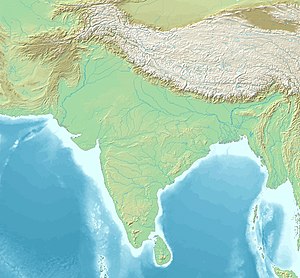| Hunas | |
|---|---|
Approximate extent of the Alchon Huns, and find spots of inscriptions related to their local control (map of the Indian subcontinent)[1] | |
| Region | Uttar Pradesh, Punjab, Rajasthan, Gujarat, Himachal Pradesh, Haryana, Jammu and Kashmir, Bihar, Sindh, Gilgit-Baltistan, Nuristan, Khyber Pakhtunkhwa, Balochistan, Maharashtra, Delhi |
Hunas or Huna (Middle Brahmi script: ![]()
![]() Hūṇā) was the name given by the ancient Indians to a group of Central Asian tribes who, via the Khyber Pass, entered the Indian subcontinent at the end of the 5th or early 6th century. The Hunas occupied areas as far south as Eran and Kausambi, greatly weakening the Gupta Empire.[2] The Hunas were ultimately defeated by a coalition of Indian princes[3] that included an Indian king Yasodharman and the Gupta emperor, Narasimhagupta. They defeated a Huna army and their ruler Mihirakula in 528 CE and drove them out of India.[4] The Guptas are thought to have played only a minor role in this campaign.[3]
Hūṇā) was the name given by the ancient Indians to a group of Central Asian tribes who, via the Khyber Pass, entered the Indian subcontinent at the end of the 5th or early 6th century. The Hunas occupied areas as far south as Eran and Kausambi, greatly weakening the Gupta Empire.[2] The Hunas were ultimately defeated by a coalition of Indian princes[3] that included an Indian king Yasodharman and the Gupta emperor, Narasimhagupta. They defeated a Huna army and their ruler Mihirakula in 528 CE and drove them out of India.[4] The Guptas are thought to have played only a minor role in this campaign.[3]
The Hunas are thought to have included the Xionite and/or Hephthalite, the Kidarites, the Alchon Huns (also known as the Alxon, Alakhana, Walxon etc.) and the Nezak Huns. Such names, along with that of the Harahunas (also known as the Halahunas or Harahuras) mentioned in Hindu texts, have sometimes been used for the Hunas in general; while these groups (and the Iranian Huns) appear to have been a component of the Hunas, such names were not necessarily synonymous. Some authors suggest that the Hunas were Hephthalite Huns from Central Asia.[3] The relationship, if any, of the Hunas to the Huns, a Central Asian people who invaded Europe during the same period, is also unclear.
In its farthest geographical extent in India, the territories controlled by the Hunas covered the region up to Malwa in central India.[5] Their repeated invasions and war losses were the main reason for the decline of the Gupta Empire.[6]
- ^ Hans Bakker 24th Gonda lecture
- ^ India: A History by John Keay p.158
- ^ a b c Haywood, John (2002). Historical Atlas of the Classical World 500BC-600AD. New York: Barnes & Noble Books. p. 2.23. ISBN 0-7607-1973-X.
- ^ Dani, Ahmad Hasan (1999). History of Civilizations of Central Asia: The crossroads of civilizations: A.D. 250 to 750. Motilal Banarsidass Publ. p. 175. ISBN 9788120815407.
- ^ Kurbanov, Aydogdy (2010). "The Hephthalites: Archaeological and Historical Analysis" (PDF). p. 24. Retrieved 17 January 2013.
The Hūnas controlled an area that extended from Malwa in central India to Kashmir.
- ^ Gerald James Larson (1995). India's Agony Over Religion. State University of New York Press. pp. 78–79. ISBN 978-1-4384-1014-2.

